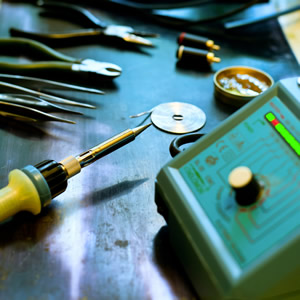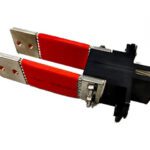The Basics of Connector Soldering
The quality of the joining processes undergone by some connectors can be a key factor in component performance. The latest article in our “Connector Basics” series by APEX Electrical Interconnection Consultants covers the basics of connector soldering.
 Many connectors and related components are subject to joining processes, which primarily involve soldering. Less commonly used joining processes include welding, brazing, and use of organic compounds, both conductive and non-conductive (epoxies, “organic solders,” etc.).
Many connectors and related components are subject to joining processes, which primarily involve soldering. Less commonly used joining processes include welding, brazing, and use of organic compounds, both conductive and non-conductive (epoxies, “organic solders,” etc.).
The distinction between soldering and brazing is somewhat arbitrary. Both processes use a filler alloy to join two surfaces without melting the substrates themselves. The basic distinction between brazing and soldering is based on the melting point of the solder (or more generally, on the temperature of the liquidus – the point when the solder is completely liquid). This boundary is commonly set at 840ºF (450ºC); below this temperature the process is considered soldering and above it is considered brazing.
Wetting and Spreading
At the initial stages of soldering, flux is applied to the substrate to be soldered; the purpose of the flux is to remove any oxide, which enables the molten solder to wet the clean substrate metal. This creates an interface between the liquid solder and the solid substrate that has lower interface energy than the clean metal/flux interface that metal/solder interface replaces. This difference in the energy compensates for the increase in the energy caused by the larger surface area of the solder that occurs due to spreading. It is this decrease in the total energy of the solder/substrate system that drives the wetting of the substrate by the solder. An alternative way of explaining the wetting process uses surface tension instead of surface and/or interface energy; this approach explains wetting and spreading in terms of balance of forces. In order for solder to wet the substrate, the surface tension of the substrate/flux interface must be larger than the vector sum of the surface tensions of the solder/substrate and solder/flux interfaces.
The molten solder interacts with the solid metal of the substrate, dissolving some of it. Dissolution rates vary a lot depending on the solder/substrate combination. These rates increase exponentially with the temperature of the solder. Solder metal also reacts with the substrate metal, forming intermetallic compounds (IMCs). The most common examples of such reactions are tin-copper and tin-nickel IMCs. The specific combination of solder-substrate metals will result in a particular IMC formation. One can identify the potential IMCs that form in a system by consulting the appropriate phase diagram. In case there are several possible IMCs, more advanced analytical techniques might be required, such as X-ray diffraction (XRD) or scanning electron energy dispersive X-ray analysis (SEM EDAX) to identify the actual phases that form under particular conditions.
Solder Joint Quality
Successful connector soldering usually presents more challenges than other PCB components because of the connectors’ larger size and greater thermal mass. Connectors may necessitate a higher processing temperature and/or longer dwell time in order to obtain adequate melting of the solder and wetting of the substrates. Higher process temperatures and longer dwell times will put more stress on the board and the rest of the components being soldered. These undesirable effects can be minimized by strict control of process parameters.
Solder joints must perform both mechanical and electrical functions. Ideally, the solder joints must be free of both external and internal defects. A good soldering process must produce solid joints with uniform appearance and good wetting of substrates and terminations. An inadequate soldering process can leave the joints vulnerable to a number of problems, resulting in low reliability. Poor and/or incomplete wetting at the interface due to oxide or contamination can lead to delamination. Internal defects, such as voids or excessive intermetallic growth, can result in cracking of solder joints. Any such defects will negatively affect the reliability of a solder joint, making it vulnerable to fatigue failure (either thermal or mechanical). Excessive intermetallic compound growth weakens the solder-substrate interface and may lead to cracking at the interface as well as delamination; some intermetallic compounds (such as gold-tin IMC) above a critical concentration could also result in embrittlement of solder.
Other Issues
There is another important requirement for a soldering process: It must not negatively affect the performance of the contact springs at the separable contact interface. Soldering temperature is usually too low and exposure time too short to affect the mechanical properties of the connector springs; however, some finishes could be vulnerable and may be affected. Extremely thin finishes can be affected by diffusion of the base metal during the high-temperature part of the soldering process, which results in oxide formation on the surface of the finish. This oxide may increase contact resistance to an unacceptable level, especially in the case of low-current and low-voltage applications. The most typical example of this is copper diffusion through gold.
Yet another issue in soldering is component solderability, particularly as it relates to shelf life, where issues such as diffusion, intermetallic compound growth, and corrosion come into play. Items to be soldered – terminations and solder tails on components, pads and plated thru-holes on printed circuit boards – must retain their solderability from the time they are produced until the time they are soldered. This is less of a concern if no significant storage time is involved (such as with just-in-time manufacturing).
However, if the parts and components are stored for any significant amount of time, their solderability can be affected. This is especially true if storage conditions that are not climate-controlled (for temperature and humidity) or parts are transported (especially by ship) with no climate-controlled storage. Presence of corrosive agents in the atmosphere during storage aggravates the situation. If doubts about solderability exist, parts may be tested prior to assembly, either by a simple dip-and-look method or by using a wetting balance (meniscograph). If parts must be stored for a prolonged time prior to use, appropriate accelerated aging tests may be performed to predict their performance after the storage.
Lead-free Process
Lead-free plating and soldering presents many additional problems to an already complex and demanding process. First, there is not a single “drop-in” composition that could replace tin-lead solder. While a large amount of research data exists for tin-lead solders, the process-applicable research on lead-free soldering is still rather limited, especially compared to a large volume of research on leaded solders. Lead-free solders generally do not wet as well as the standard 60% tin-40% lead solder. Lead-free solders also fully melt at higher temperatures compared to the tin-lead solder, except for some specialty solders that tend to be expensive. Therefore, lead-free solders require higher processing temperatures, which could negatively affect all components. Because of higher processing temperatures, process controls must be much tighter. In addition, lead-free contact finishes that must be used in conjunction with lead-free solders are generally either less solderable or introduce other problems such as joint embrittlement by gold and tin whisker growth with pure tin finishes.
Robust soldering and joining processes are essential to the reliability of most electronics and electrical equipment.
[hr]
 Joseph Haimovich, senior consultant at APEX Electrical Interconnection Consultants, has more than 28 years experience in the connector industry. He specializes in the metallurgy of base materials, contact coatings, solders, and finishes, particularly tin and tin alloys, as well as lead-free finishes. He contributes to the development of new and improved types of contact coatings such as hot-air leveled tin (HALT) and initiatives supporting RoHS. Joseph provides technical support in development of new products, surface-mounting/solder reflow, failure analysis, and technical training. He can be reached at [email protected].
Joseph Haimovich, senior consultant at APEX Electrical Interconnection Consultants, has more than 28 years experience in the connector industry. He specializes in the metallurgy of base materials, contact coatings, solders, and finishes, particularly tin and tin alloys, as well as lead-free finishes. He contributes to the development of new and improved types of contact coatings such as hot-air leveled tin (HALT) and initiatives supporting RoHS. Joseph provides technical support in development of new products, surface-mounting/solder reflow, failure analysis, and technical training. He can be reached at [email protected].







